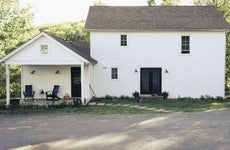HO-5 insurance: what it covers and who might need it

The Bankrate promise
At Bankrate, we strive to help you make smarter financial decisions. To help readers understand how insurance affects their finances, we have licensed insurance professionals on staff who have spent a combined 47 years in the auto, home and life insurance industries. While we adhere to strict , this post may contain references to products from our partners. Here's an explanation of . Our content is backed by Coverage.com, LLC, a licensed entity (NPN: 19966249). For more information, please see our .
When shopping for home insurance, you may be surprised to learn just how many different types of homeowners policies are available. It can be a lot to navigate and leave you with questions. For those looking for insurance that offers more coverage than the traditional HO-3 policy, HO-5 insurance may be appealing — but not all homes qualify for it. Bankrate explains who might benefit from HO-5 coverage and which homes are eligible.
What is an HO-5 insurance policy?
An HO-5 policy is a homeowners insurance policy type that covers your home and personal belongings under open perils coverage, except for certain exclusions. This differs slightly from a standard HO-3 homeowners policy, which covers your home’s structure on an open perils basis but your personal possessions only for named perils. As an open perils policy, an HO-5 insurance policy will list out exclusions. That means your policy covers any scenario that is not specifically excluded.
What does an HO-5 policy cover?
Home insurance policies can often be customized to fit your needs, so your exact coverage will depend on your specific policy. However, there are several components of a standard HO-5 policy, including:
- Dwelling coverage: The structure of your home is typically covered on an open perils basis. This means that you are covered for any loss that is not specifically listed as an exclusion.
- Personal property coverage: Your belongings are also typically covered on an open peril basis, so anything not excluded is covered.
- Other structures coverage: HO-5 insurance also provides protection for structures that aren’t attached to your home, such as a detached garage, backyard shed or fence.
- Liability coverage: Another standard feature of an HO-5 policy is liability coverage. This may financially protect you in the event someone is injured while at your home or you are found liable for damaging someone’s property. It may also cover legal fees and settlement costs if someone tries to sue you.
- Medical payments coverage: This may help cover medical expenses if a guest is injured on your property, depending on fault.
- Loss of use coverage: HO-5 may also cover additional living expenses like hotel and meal costs if your home is damaged from a covered claim and you can’t live in it while it’s being worked on.
HO-5 policy endorsements
There may also be ways to customize your HO-5 home insurance policy to further meet your needs with additional standalone policies or homeowners insurance endorsements. Some endorsements you may be able to include are:
- Sewer and water backup: This endorsement covers your home against damage resulting from sewage backup or a failing sump pump.
- Identity theft: Identity theft coverage may help reimburse you for out-of-pocket expenses related to identity theft, like the cost of restoring your credit and attorney fees.
- Scheduled personal property: Scheduled personal property coverage helps protect high-value possessions, like an expensive diamond ring or firearm.
- Earthquake insurance: An earthquake insurance add-on or policy provides protection against earthquake damage to your home, unattached structures on your property and personal belongings.
- Personal property replacement coverage: Personal property coverage helps pay to repair or replace your belongings — for example, a laptop or furniture — that are damaged by a covered event.
- Flood insurance: Flood insurance covers your home and personal belongings against losses due to direct flooding — a rain storm, for example.
While flood insurance is usually a separate policy from home insurance, earthquake coverage may be available as either an endorsement or a standalone policy, depending on your state and carrier.
HO-5 policy exclusions
As an open perils policy type, HO-5 coverage typically has a pretty long list of exclusions. Checking your policy for a comprehensive list of HO-5 exclusions may be a good idea; every company is different and exclusions could vary. However, the following homeowners insurance exclusions are fairly standard across HO-5 policies:
- Earth movement
- Power failure
- Nuclear hazard
- Collapse
- Settling or expanding
- Mold, fungus or rot
- Smog or corrosion
- Ordinance or law
- Neglect
- Intentional loss
- Theft from a building under construction
- Birds or vermin
- Typical wear and tear
- Smoke from agricultural or industrial site
- Water damage from sewer backups, floods or seepage
- War
- Government action
- Vandalism of vacant properties
- Mechanical breakdown
- Pollutant discharge
- Owned animals
That might seem like a long list of exclusions. However, remember that damage caused to your home or personal belongings is covered under an HO-5 policy unless specifically excluded by your property insurer.
What is the difference between HO-3 and HO-5 policies?
HO-3 policies are the most common type of homeowners insurance. Both HO-3 and HO-5 policies cover your dwelling — the structure of your home — on an open perils basis.
The difference between HO-3 and HO-5 is in how each policy form covers your personal property. With an HO-5 policy, you get open perils coverage for your belongings, but with an HO-3, your items are covered on a named perils basis. This means that your personal property is only covered for the perils specifically listed in the policy, and anything else is considered excluded.
Who is eligible for HO-5 insurance?
Eligibility for HO-5 insurance typically depends on several factors, including the condition of the property, its location and the homeowner’s claims history. Generally, homeowners who own newer or well-maintained homes in areas that are considered low risk for natural disasters and other potential threats may be eligible for HO-5 insurance. It’s worth noting that eligibility criteria can vary between insurance companies, so it’s essential to consult with an insurance agent to determine if HO-5 insurance is available and suitable for your specific circumstances.
Who needs HO-5 coverage?
You don’t have to own a high-value home to want HO-5 coverage. Because HO-5 policies offer open perils coverage on both the dwelling and your personal property, your finances will be better protected against a wider range of scenarios. Homeowners may opt for this robust insurance as a financial safety net against potential damage. However, HO-5 coverage is typically more expensive than a standard HO-3 policy due to its more broad coverage. Therefore, it may not be ideal for homeowners on a tight budget.
How much does an HO-5 policy cost?
The cost of an HO-5 policy is usually more expensive than an HO-3 policy, as it provides more financial protection for your personal property against a wider range of perils. Home insurance pricing depends on several factors, including your coverage types and limits, your location, the age of your home, the square footage and the condition of your home. For an HO-3 policy, the average cost of home insurance for $250,000 in dwelling coverage is $1,687 per year. You can generally expect to pay more than that for a similar HO-5 policy.
Frequently asked questions
-
-
You can buy HO-5 insurance from many homeowners insurance companies across the country. Most carriers offer both the HO-3 and HO-5 policies, so you can get a quote to compare both policies if you are unsure which you want. Online quote forms may have an option to select the policy type you want, and if they don’t, you might want to call the carrier for clarification.
-
Whether an HO-3 or HO-5 is better depends on your wants and needs for your homeowners insurance policy. For instance, an HO-5 has broader coverage, especially for personal property, but may be more expensive than an HO-3 policy. If you do not need open perils coverage on personal property, you may be able to save on your annual premium with an HO-3 policy form.
-
Like most home insurance policies, an HO-5 policy doesn’t usually include coverage for identity theft. However, some carriers may include this or have it available for purchase as an endorsement.
-
Related Articles



